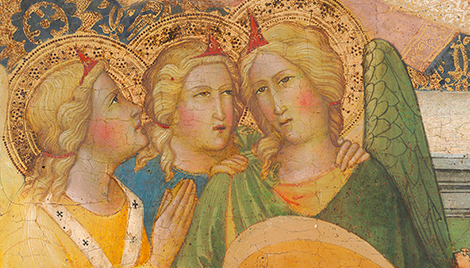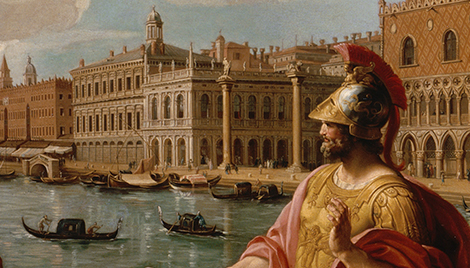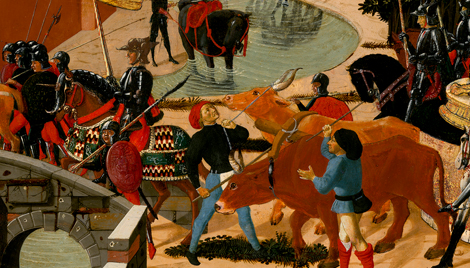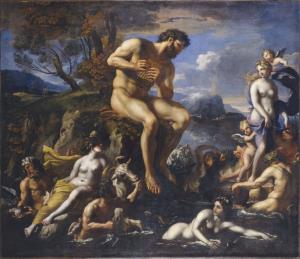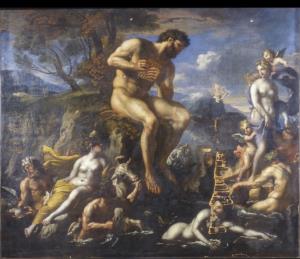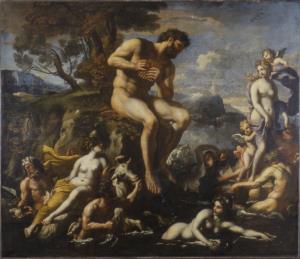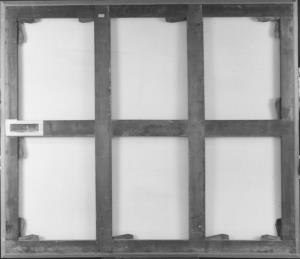Polyphemus and the Sea Nymphs
Polyphemus and the Sea Nymphs
- Artist
- François Perrier
- Artist Dates
- 1594-1649
- Artist Nationality
- French
- Title
- Polyphemus and the Sea Nymphs
- Date
- c. 1620-40
- Medium
- oil on canvas
- Dimensions
- 149.9 x 174.7 cm (59 x 68-3/4 in)
- K Number
- K1636
- Repository
- Samek Art Museum
- Accession Number
- 1961.K.1636
- Notes
Provenance
John Watkins Brett [1805-1863], as Annibale Carracci; (his sale, Christie's, London, April 1847); Abraham Darby IV [1804-1878], Stokes; [1] probably (his sale, Christie's, London, 8 June 1867, no. 125, as A. Carracci, Triumph of Galatea); acquired by Brisco. Art dealer, Richmond, Surrey; acquired 1914 by Sir Herbert Frederick Cook, 3rd bt. [1868-1939], Doughty House; by inheritance to his son, Sir Francis Ferdinand Maurice Cook, 4th bt. [1907-1978], Doughty House, and Cothay Manor, Somerset; (Count Alessandro Contini Bonacossi [1878-1955], Florence - Rome); sold to the Samuel H. Kress Foundation on 10 March 1949 as Francois Perrier; gift to to the Samek Art Museum Bucknell University in 1961. [1] Exhibited Art Treasures of the United Kingdom, Manchester, 1857, p. 35, Cat. No. 333 as Annibale Carracci.
Catalogue Entry
François Perrier
Polyphemus and the Sea Nymphs
K1636
Lewisburg, Pennsylvania, Bucknell University, since 1961. Oil on coarse Italian canvas. 59 x 68 3/4 in. (149.9 x 174.7 cm.). Label formerly on back stated that K1636 was lent to the Manchester Art Treasures Exhibition (1857) by Mr. A. Darby, Cat. No. 916 as 'Polyphemus and Galatea by A. Carracci'. Relined and restored by Modestini in 1967-68. Long vertical tear on right side from sky to swimming figure at bottom. Several pentimenti in arm of figure at lower right. Blanchard Gummo, A study collection of Renaissance art, gift of the Samuel H. Kress Collection, Bucknell University, Lewisburg, Pa., 1961, p. 44. A nude one-eyed giant –Polyphemus, son of Neptune and the nymph Thoösa –is seated on a cliff at the water's edge; he holds pipes of Pan (syrinx) and is turned toward a young female nude, his beloved Galatea, who stands at the right surrounded by billowing drapery. A putto holds drapery above her; another is at her side. Galatea seems to hide Acis, the young man crouched at her side, by partially covering him with her veil. Acis was later killed by Polyphemus. Galatea stands upon a shell-vessel with a dolphin at the side and a merman and two nereids at the front and back. Two men on seahorses, one blowing a conch, arc to the right of Polyphemus. A nereid swims in the right foreground; another nereid riding on a goat is in the left foreground. At her right is a sea god with a conch who points toward Polyphemus, and at her left is a marine figure with leaves in his hair, who grasps the goat's beard with his left hand and holds its rope in his right. The painting shows Polyphemus wooing Galatea. The artist, like Annibale Carracci, whose Palazzo Farnese fresco he has partially followed in the canvas, also drew upon the text of Philostratus (Imagines, II, 18).(1) The purple color of Galatea's scarf follows the latter. The canvas is probably the one first published by Waagen as a work of Annibale Carracci, showing 'Polyphemus and the Sea Nymphs'.(2) It is described as differing from the representation of the same subject by Annibale at the Farnese Palace, and 'of great energy of drawing and expression, and capitally executed in a powerful brown tone'. If identical with K1636, it was then obscured by discolored varnish. It was recorded as by Annibale Carracci in the Cook Collection catalogues of 1915 and 1932.(3) Longhi attributed the canvas to François Perrier, listing it as 'Polyphemus on the cliffs with Galatea and other figures of nymphs and tritons'. He noted the influence of Lanfranco's Polyphemus and Galatea (Rome, Galleria Doria-Pamphili) as well as that of Pietro da Cortona, finding this fusion of Bolognese and Cortona-like elements characteristic of Perrier, seen in the French artist's Bacchanal (Rome, Galleria Capitolina). Longhi dated the canvas c. 1645 when Perrier was in Rome.(4) According to Manning the canvas stems from Perrier's second Roman residence of c. 1645, close in date to a Bacchus and Ariadne in the Manning Collection.(5) The group at the left is freely adapted from a Classical Nereid sarcophagus such as the one which was at San Francesco a Ripa (Rome), moved to the Capitoline in the eighteenth century and taken to the Louvre in 1797.(6) Perrier was especially drawn to mythological subjects with aquatic references as were his colleagues in Rome, Vouet and Poussin.(7) He painted a Neptune and Aeolus (Rome, art market), a Triumph of Amphitrite (Carcassonne, Musee de Beaux-Arts) and a Venus Imploring Neptune (Épinal, Musee Departemental des Vosges).(8) An early record of Perrier's works states that he often repeated the subject of Polyphemus and Galatea with great variety in composition. Another version of this subject by Perrier in the Louvre reverses the composition of K1636; Polyphemus is far smaller in scale, and the canvas is more Poussinesque. As in K1636, Acis is hidden by drapery, and the sea-borne chariot is much the same.(9) The male figure at the lower right of K1636 is adapted from Raphael's Galatea of 1513 (Rome, Villa Farnesina); the composition in general relates to Annibale Carracci (Rome, Galleria Farnese). Perrier was deeply concerned with the art of the Carracci, his familiarity with the Farnese Gallery being such that he made drawings after rejected as well as executed subjects for the fresco cycle.(10) The group at the lower left is taken from Lanfranco's depiction of the same subject (Rome, Galleria Doria-Pamphili).(11) The same subject by Poussin (Dublin, National Gallery of Ireland), variously dated between the mid-1620s and 1631, like K1636, depends upon Carracci and Lanfranco and may have been painted at about the same time as the Kress canvas.(12) The figures in the Kress canvas resemble those in Perrier's fresco of Juno and Aeolus (Rome, Palazzo Peretti-Almagia), painted between 1624 and 1629. K1636 may date from a Lanfranco influenced phase of the later 1620s or from the 1640s, when Perrier was again following that Italian master and the new classical style of Poussin (which was itself partially determined by Lanfranco). The earlier dating will probably prove to be correct; it is also indicated by the execution of the Kress painting on Italian canvas. Provenance: Possibly identical with a canvas listed by Waagen as Annibale Carracci, Polyphemus and the Sea Nymphs. If so, it appeared in the Lord Northwick sale, Northwick Park, 1859, Cat. No. 119, p. 13, 'A. Carracci, Polyphemus and the Sea Nymphs', purchased by A. J. Abrahams for five guineas. Abraham Darby, exhibited –London, Art Treasures of the United Kingdom Collected at Manchester, 1857, p. 35, Cat. No. 333 as Annibale Carracci, Polyphemus and Galatea. Art dealer, Richmond, Surrey. Purchased by Herbert Cook, 1941. Listed by him as Annibale Carracci, Polyphemus and the Sea Nymphs.(13) Florence, A. Contini Bonacossi. Kress acquisition 1949.
References
(1) See the edition translated by Blaise de Vigenère, Paris, 1637, pp. 436 ff. The illustration opposite page 436 shows a Galatea similar to that of Perrier. The latter may have had access to the print, since the Vigenère illustrations were prepared long before Vigenère's edition was published in 1637. See John Rupert Martin, The Famese Gallery, Princeton, 1965, p. 109, for a discussion of the Carracci frescoes' iconography. For the iconographical background of K1636 and related subjects see Jan Bialostocki, 'The Sea-Thiasos in Renaissance Sepulchral Art', Studies in Renaissance and Baroque Art presented to Anthony blunt his 60th Birthday, London and New York, 1967, pp. 69-74. (2) Gustav Friedrich Waagen, Treasures of Art in Great Britain, London, 1854, III, p. 200. As in the Collection of Lord Northwick, Cheltenham. (3) Herbert Cook, Catalogue of the Paintings at Doughty House, Richmond ... , London, 1915, p. 182, Cat. No. 540. Also Maurice Brockwell, Abridged Catalogue ... , London, 1932, p. 82, Cat. No. 540. (4) Transcription of certificate by Roberto Longhi of Dec. 1948 in Kress Archive. This view is repeated by Longhi in a note appended to the Schleier article, op. cit. Note 1, p. 54. (5) Robert L. Manning, A Loan Exhibition, Vouet to Rigaud, Finch College, New York, 1967, Cat. No. II. (6) See Andreas Rumpf, Die Meerwesen auf den antiken Sarkophagreliefs, Berlin, 1939, no. 132. Reference courtesy of Phyllis Bober. (7) Reproduced in France. Centre National de la Recherche Scientifique, Colloques Internationaux. Sciences Humaines, 1958: Nicolas Poussin, ed. André Chastel, Paris, 1960, II, fig. 245. (8) The first painting is reproduced by Erich Schleier, 'Affreschi di François Perrier a Roma', Paragone, n.s., 37, no. 217, Mar. 1968, fig. 23. The Galatea in the Carcassonne canvas is close to that in K1636. (9) Comte de Caylus and P. J. Mariette, Vie de François Perrier Peintre (MS. Bibliothèque Nationale, Paris), passim. The Louvre painting is reproduced in color by Jacques Thuillier and Albert Châtelet, French, Painting from Le Nain to Fragonard, Geneva, 1964, p. 67. (10) Roseline Bacou, 'Two unpublished Drawings by Annibale Carracci for the Palazzo Farnese', Master Drawings, 1964, II, pp. 40-4. (11) A Galatea from the School of Vouet is discussed by William R. Crelly, The Paillting of Simoll VOllet, New Haven and London, 1962, pp. 202-3, no. 114. (12) For the Poussin, see Anthony Blunt, The Paintings of Nicolas Poussin, London, 1966, p. 89, Cat. No. 128. For the relationship between Perrier and Poussin, see Thuillier, 'Poussin et ses premiers compagnons français à Rome', Actes, I, 1960, pp. 71-116, esp. pp. 83-4. (13) See catalogues of 1915 and 1932 (see Note 3 above). Herbert Cook recorded the conflicting provenance as given, expressing uncertainty as to its accuracy, p. 82.

